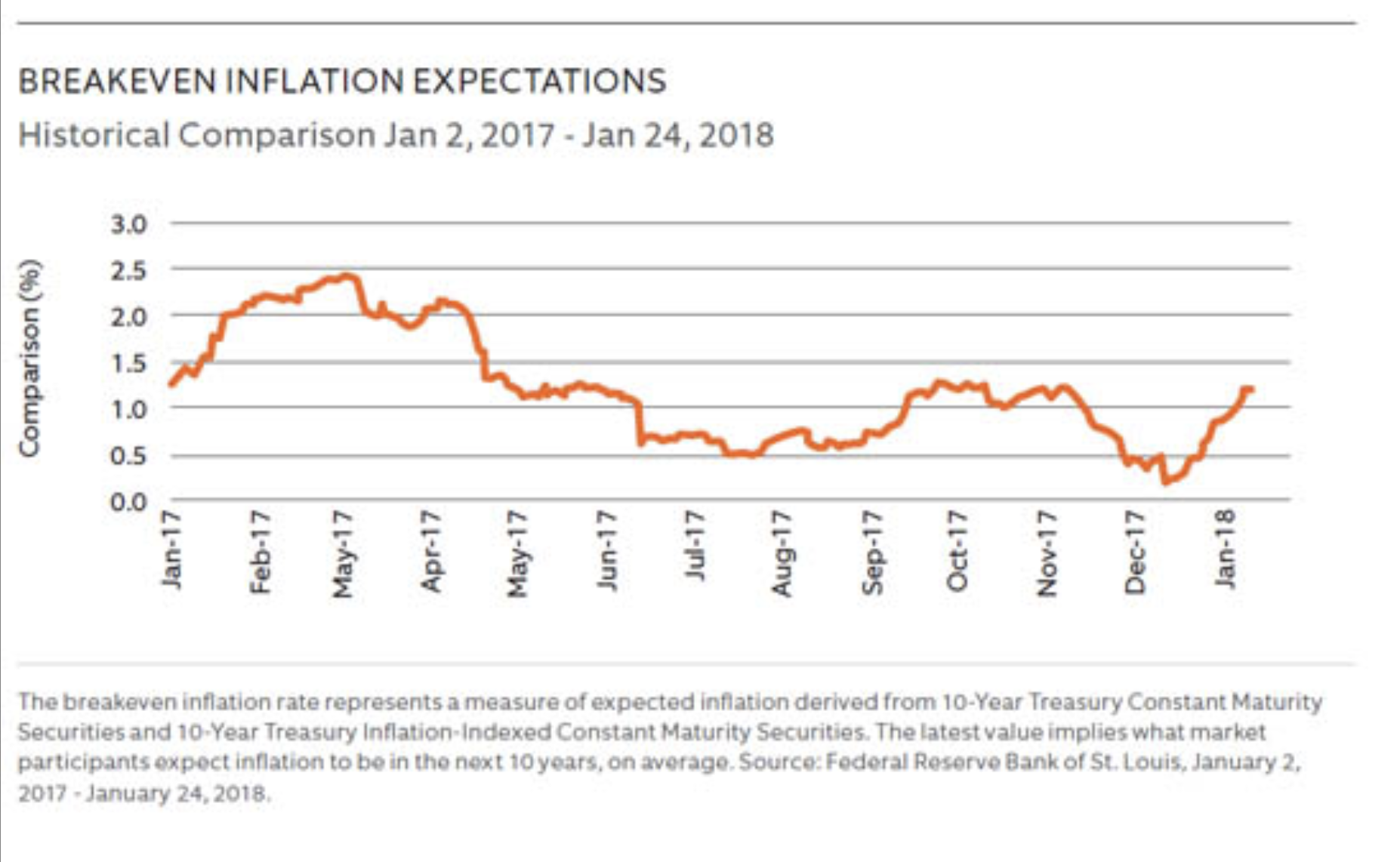
How real is the threat of increasing inflation? This has been a lively issue of debate among economists, financial advisors and investors for a long time. Only recently has a strengthening global economy, impressive employment growth figures in the U.S., ongoing Fed interest rate hikes and a flattening yield curve contributed to a more uniform consensus that inflation is likely to increase, rather than decrease, in the coming months. Investors who share this belief may wish to consider adding Treasury Inflation Protected Securities (TIPS) to their fixed income portfolios.
The Market’s Inflation Outlook
The decision to invest in TIPS should be based in part on an investor’s beliefs in whether prices will rise or fall over time.
Investors seeking guidance can find the market’s current outlook in the Federal Reserve’s Breakeven Inflation Expectation Rate (BEI). BEI measures yield spreads between current fixed-rate Treasuries and comparable Treasury inflation-indexed securities with similar maturities. This analysis reveals the market’s current inflation expectations, as shown in the chart below.

Key Drivers of Higher Inflation Expectations
Through most of 2017, inflation expectations were relatively muted, but started to rise sharply at the end of the year. The rebound of the BEI rate from its December trough reflected predictions that President’s Trump’s newly enacted tax reforms would spur economic growth that would generate higher inflation. Expectations continued to rise in 2018 in response to an array of positive economic indicators, including solid job creation, positive GDP growth, rising wages, and increasing consumer confidence.
The declining dollar and continued accommodative stance of many foreign countries has also driven higher inflation expectations. While the Fed continues to raise interest rates here in the U.S., many European nations are still committed to maintaining their Quantitative Easing Programs.
Unable to find attractive yields at home, many foreign banks and sovereign wealth funds seek higher yields from U.S. fixed income securities, which is flattening the yield curve. More foreign capital flowing into the U.S. could stimulate more economic growth, which, in turn, could drive prices higher.
More recently, the Trump administration’s imposition of tariffs on imported steel and aluminum has created further concerns that prices for automobiles, construction materials and consumer goods here in the U.S. could rise significantly as well.
While some investors attempt to compensate for inflation by increasing exposure to equities, we believe that TIPS can provide similar protection without incurring additional investment risk.
Using the BEI Rate as a TIPS Decision Factor
The BEI rate offers a way for inflation-wary investors to determine whether they should add TIPS to their portfolios. If an investor believes that inflation will be the same or higher than the BEI rate, he or she may want to invest in TIPS to provide a hedge against inflation.
Managing Duration Risk within a TIPS Allocation
Many investors carefully monitor and manage the durations of their fixed income allocations. This is relatively easy to do with fixed-rate bonds, but floating rate securities such as TIPs can present a challenge. That’s because the duration of a given TIPS bond will change depending on its inflation-adjusted yield. Rising inflation will shorten duration, while lower inflation will lengthen it.
Fortunately, FlexShares provides a way for investors to manage TIPS duration risk through its FlexShares iBoxx® Target Duration TIPS Index ETFs.
Two Inflation-Hedging Strategies
FlexShares two ETFs--The FlexShares iBoxx® 3-Year Target Duration TIPS Index Fund (TDTT) and the FlexShares iBoxx® 5-Year Target Duration TIPS Index Fund (TDTF)—offer the inflation-protection benefits of TIPS while providing targeted duration exposure through changing interest rate and economic cycles.
These ETFs are designed to track the returns of their associated IBoxx® Duration TIPS indices. The indices are created and managed using the following process:
- A universe of investable TIPs bonds is defined, constrained to those with at least $2 billion of outstanding issues and maturies ranging from 1 to 10 years.
- The associated IBoxx® index is constructed starting with five “core bonds” with the shortest distance to the index’s designated (three or five year) duration.
- The Average Modified Adjusted Inflation (MAD) of the index is calculated. MAD estimates the market duration of a specific TIPS, providing a way to compare the interest rate sensitivity of TIPS to other fixed income securities based on inflation expectations.
- If the calculated MAD is above or below the index’s targeted durations, the highest or lowest duration TIPS bond or bonds are liquidated and proceeds are distributed pro rata to the remaining core bonds until the index’s overall duration falls within plus or minus 5% of the target duration.
- The index is rebalanced on a monthly basis.
Incorporating the Funds into Investors’ Portfolios
Either ETF—or both—may be appropriate for investors, depending on the role they expect them to serve in their portfolios.
- Investors may choose the Fund whose duration most closely aligns with the overall duration of their fixed income portfolio.
- Investors may choose the Fund they believe aligns with their own inflation expectations. For example, they may choose TDTT if they believe that inflation will rise significantly over the short term. Or, they may choose TDTF if they believe inflation will increase only moderately over the long term.
- Some investors may wish to add allocations to both Funds to provide a wider range of inflation-hedging diversification to their portfolios.
Investors who are concerned that rising inflation could erode the value of their portfolios may benefit by adding exposure to TIPS. FlexShares IBoxx® Target Duration TIPS Index Funds offer two cost-effective strategies to gain this exposure without causing significant imbalances in the target duration of their fixed income allocations.
Learn more about FlexShares iBoxx® Target Duration TIPS Index Funds and download their complimentary whitepaper, Stoking the Inflation Fire.
Mark Carlson is a Senior Investment Strategist for FlexShares Exchange Traded Funds (ETFs) at Northern Trust Asset Management.
--
IMPORTANT INFORMATION
Before investing, carefully consider the FlexShares investment objectives, risks, charges and expenses. This and other information is in the prospectus and a summary prospectus, copies of which may be obtained by visiting www.flexshares.com. Read the prospectus carefully before you invest.
Foreside Fund Services, LLC, distributor.
An investment in FlexShares is subject to numerous risks, including possible loss of principal. Fund returns may not match the return of the respective indexes. A full description of risks is in the prospectus.
FlexShares iBoxx® 3-Year Target Duration TIPS Fund (TDTT) and the FlexShares iBoxx® 5-Year Target Duration TIPS Index Fund (TDTF) are passively managed and primarily use a replication strategy to track their underlying index. Use of a replication strategy creates tracking risk where the Fund’s performance could vary substantially from the performance of the underlying index along with the risk of high portfolio turnover. They may invest in derivative instruments. Changes in the value of the derivative may not correlate with the underlying asset, rate or index and the Funds could lose more than the principal amount invested. The Funds are subject to fluctuation of yield risk, income risk, inflation protected security risk and interest rate/maturity risk. The Funds are non-diversified meaning the Funds’ performance may depend on the performance of a small number of issuers because the Funds may invest a large percentage of its assets in securities issued by or representing a small number of issuers.
The iBoxx® 3-Year Target Duration TIPS Index and iBoxx® 5-Year Target Duration TIPS Index are the intellectual property (including registered trademarks) of Markit iBoxx® and/or its licensors ("Licensors"), which is used under license. The securities based on the Index are in no way sponsored, endorsed, sold or promoted by Markit iBoxx® and its Licensors and neither of the Licensors shall have any liability with respect thereto.
1 Source: Federal Reserve Bank of St. Louis, 10-Year Breakeven Inflation Rate [T10YIE], retrieved from FRED, Federal Reserve Bank of St. Louis.



